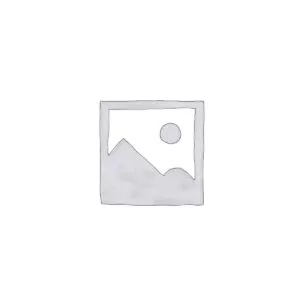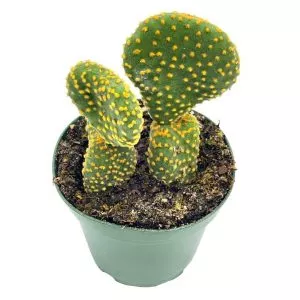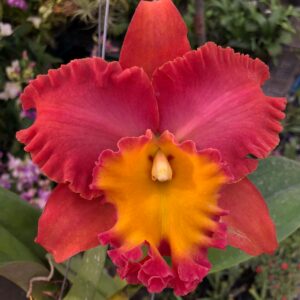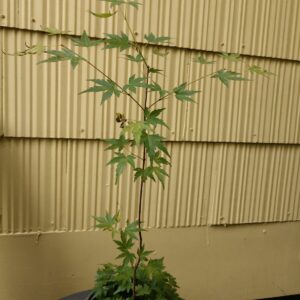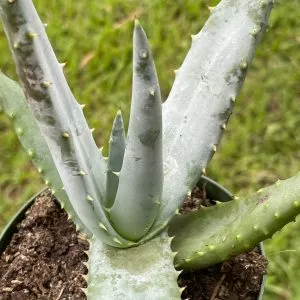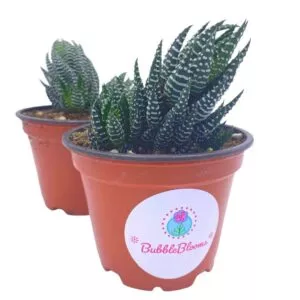No products in the cart.
Table of Contents
Ice cream banana yum yum! Yes, gardeners, you can grow your pudding and even eat it when you have a blue java banana tree. Yip the tree carries incredible fruit that starts in a blue color like a fairytale but ripens to a creamy yellow color. And did we mention it tastes divine, just like vanilla ice cream?
Wow, that makes one hungry, right? These trees are growing in popularity worldwide, and you can also have one in your yard and take care of it with the information provided here.
What is an Ice Cream Banana?

The ice cream banana is a product of two hybrid species known as the Musa acuminata and Musa balbisiana. These are classified into two groups A or B. The blue java bananas belong to the ABB group as it comprises a set of genes from the A group and two from the B group.
In the Musa acuminata, a common banana tree is the Cavendish banana used for desserts, while the Musa balbisiana people use it primarily as plantains for cooking. But the ice cream banana trees come from both of these stocks and have a gooey yet rich vanilla custard taste.
While you find them mainly growing in Southeast Asia, they are found in other tropical parts. The banana plant grows from a rhizomatic corm with a base extending about 18 inches into the ground to produce the root system.
Out of the rhizome grows one stalk known as the false stem forming the trunk of the tree. The cylindrical stalk has tightly packed leaves growing up from the corm. When the tree starts to bear fruit, it sends up another stem known as the true stem growing through the middle of the central stalk and out.
On this stem, you get a single flower developing, and as it blooms, each petal peels back to form shade for the collection of banana flowers. Once the blue bananas form, it looks pretty as it begins underneath the petal and when none open anymore you can remove the flower for the fruit to develop.
Ice Cream Banana Tree Care
Caring for your ice cream banana plant is pretty straightforward, but you need to give them the right start. Before we get to the Java banana care, check out the detailed information on the basic care tips here:
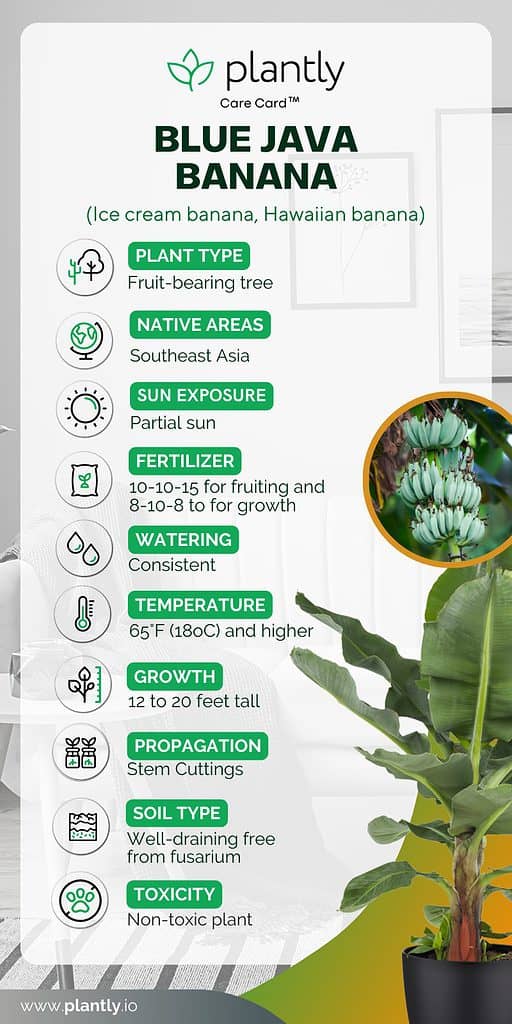
Banana Trees Soil Needs
For growing blue java bananas, the potting mix needs to be with good drainage. Like most banana trees, the root systems are susceptible to fungal diseases like pythium causing root rot. Further, they are sensitive to fusarium-causing banana wilt as well, both caused by overwatered soil.
It’s best to start with a blend of sterile soil. If not possible, we recommend solarizing your soil a couple of months before to reduce the risk of pathogen infection. After that, we recommend using coconut coir, worm castings, peat moss, and 20% of its perlite for drainage.
If you decide to use quality compost, the greater ingredient is adding sandy soil instead of clay. Your blue java plant prefers neutral to acidic soil with a pH level between 5.5 to 7.0.
Best Lighting Conditions for Ice Cream Bananas
Many gardeners will tell you the planting location for the ice cream banana tree is in full sun. But, the perfect condition is to grow them in the sun with partial shade. It helps promote leaf growth significantly in the beginning stages of development.

So if you can provide the tree with 30-50% shade, it should bear delicious fruits. Another important thing is to give the tree at least 12 hours of sunlight a day.
Water Needs To Prevent Banana Wilt
Banana plants thrive in warm weather, and this tropical species needs frequent quenching. But remember that they do not tolerate standing in water. That is why the soil needs to be well-draining to prevent the pooling of water during rainy seasons.

If you want to play it safe, you can use a soaker hose placed around the base for deep soaking. So water your java bananas regularly unless it rains a lot. You can do this every alternate day, taking into consideration that the soil drains well.
Humidity and Temperature Requirements
Blue java plants thrive in temperatures ranging from 65° F (18oC)and above and will prosper. While they can tolerate cold temperatures compared to other varieties, providing them with a wrap is best if the temperature goes below 20°F (-6.7oC).
Just as much as your banana thrives in high temperatures, it needs ambient humidity but can survive in ranges of 50%. If your house has all access to sunlight in all directions, then feel free to treat them as an indoor plant. Just make sure that you replicate another requirement necessary for them to bear fruits.
-
Free Shipping$9.99 – $18.99Sold By: Thor's Backyard Nursery
In stock (can be backordered)
Agave Blue Glow | HUGE BULK SALE!!! (Read Description)
Rated 4.89 out of 5 based on 53 customer ratings01Sold By: Thor's Backyard Nursery -
$18.99Sold By: Succulent Oasis
$28.00In stock
Large Succulent Plant Aeonium ‘Lily Pad’ Hybrid. A beautiful Hybrid.
Rated 4.84 out of 5 based on 352 customer ratings00Sold By: Succulent Oasis -
$19.99Sold By: BubbleBlooms
In stock
Crested Bunny Ears Prickly Pear, Opuntia microdasys, in 4 inch pot, Clumped Rare Cacti
Rated 4.81 out of 5 based on 279 customer ratings00Sold By: BubbleBlooms -
$34.99Sold By: Aloha Hawaii Orchids
$39.99In stock
Rlc. Orange Diamond ‘Throat of Gold’ Comes in 2″ Pot
Rated 4.65 out of 5 based on 268 customer ratings00Sold By: Aloha Hawaii Orchids
Fertilizing Your Blue Java Banana Plants
Feeding your banana tree helps to have a fertilizer with a high phosphorous level to produce fruit. You can use a balanced 8-10-8 or one that is 10-10-20. You can do this in the growing season but best to stop in winter as your tree becomes dormant.
Ice Cream Banana Tree Propagation
One thing you’ll find with your ice cream banana trees is that they are exceptionally unreliable. The majority of these plants are hybridized and seldom produce seed, and if they do, the seed is not sterile. Yet, there are rare cases where seeds are produced, but it has low germination.
So the best is to buy a plant already developed from the tissue culture, or you need to divide the pups off from the corm carefully. This is a bit tricky as you do not want to damage them.
USDA Growth Zone

Blue java banana is not frost tolerant. This plant performs well in the USDA zones nine to ten but grows in zones eight to eleven. If the location is between 50°F to 90°F (10 to 32oC) in the daytime and does not drop below 20°F (-6.7oC), it should thrive. Your tree is tolerant to heat and flourishes like a champ.
Potting and Pruning Your Ice Cream Banana Tree
So how do you plant your ice cream bananas? You can plant it in your yard in a huge pot or in the garden outside. Here you can find the method for growing them as an outdoor plant:
- Dig a massive hole twice as wide and deep.
- Plant the rhizome below the soil surface, ensuring it is level with the ground to stand up straight.
- Fill the hole with your potting mix and press it down to remove the air pockets.
- Place some mulch around the tree and give it a good watering.
Now, you can tightly bound the leaf sheaths looking like stems to help them sprout up. You will notice the true stem developing 15 months after planting. Then a bundle of flowers will bloom, and the delicious fruit you will pick after 150 days of emerging.
One thing you’ll love about this fruit tree is it needs minimal pruning. Yes, you do not need to prune often, and everything is done around the base of the mature stalk. But make sure not to remove all of the pups, only the weak ones. Instead, select the vigorous ones to remain once the false stem is in six months of growth.
The only time you remove the leaves is when they are yellow or brown or shriveled and quickly pulled off. Once the true stem is finished fruiting, another task needs to be done. The fault stalk only produces a single fruit harvest and needs to be cut back to the corm.
Doing this allows the pups to develop over the next year. When you prune your tree, always use sterilized pruning shears to prevent the transmittal of disease.
Banana Varieties
While the blue java banana tree is a famous fruit tree, there are other species you can grow.
Cavendish Bananas

The fruit is the most common variety found in most United States supermarkets. You see them in young unripe green to ripe bananas with smooth yellow to dark brown spots. The fruit is delicious in pancakes, bread, and smoothies.
Gros Michel
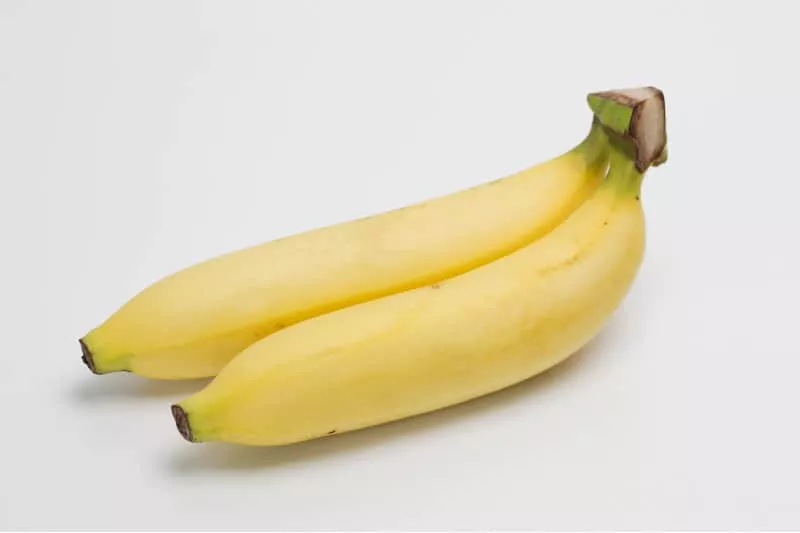
The banana has a similar taste to the Cavendish but is not as available freely compared to other varieties. It has a sweet taste with a strong smell and creamier texture in banana pies.
Lady Finger
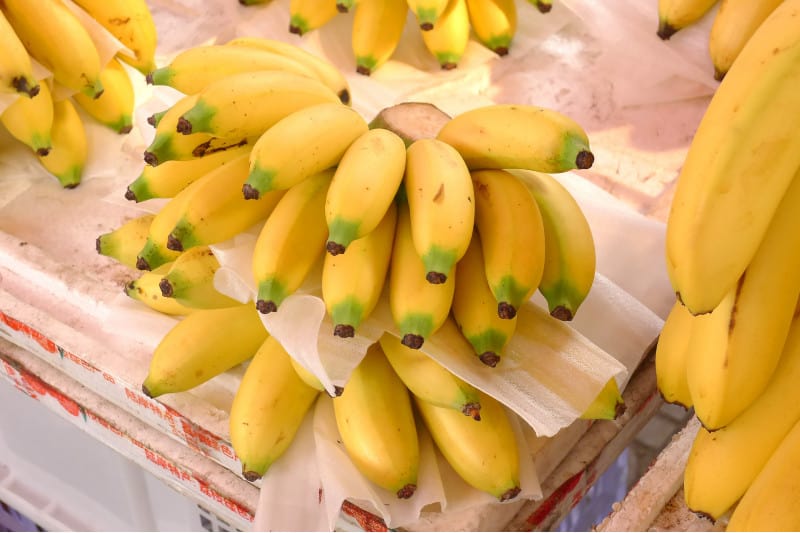
These bananas are up to five inches long with a cigar shape and bright yellow thin peel with dark specks. The creamy flesh is very creamy and delicious.
Blue Java Banana Diseases & Pests
Your ice cream banana can have problems with pests and diseases. You can find piercing insects from spider mites to banana aphids. These pets sap the suck out from the fronds, and the aphids can spread diseases. You can street both pests with neem oil, but you may need to use pyrethrin if it is a large outbreak.
Another insect is mealybugs making a home on the leaves and can be removed using cotton wool dipped in alcohol but for larger batches, use an insecticidal soap. Finally, it would be best to keep an eye on the banana rust thrip causing severe damage. To remove these pests, you can use pyrethrin to control them.
The banana fruit scarring beetle attacks the fruit, and sticky traps work for them. Lastly, you get root-knot nematodes that are a real problem for the roots of the plant. To deal with the problem, it helps to introduce beneficial nematodes.
Common diseases are as follows:
- Fusarium oxysporum is a fungal pathogen caused by the Panama disease or banana wilt. The condition is lethal to your ice cream banana. You will notice drooping fronds with yellow leaves. Unfortunately, there is no cure and transmitted through the soil, uncleaned tools, and the wind. You’ll need to destroy your tree and never plant any other foliage in the ground.
- Sigatoka and a black leaf streak are two types of leaf problems. You can treat both with a liquid copper fungicide.
- Banana bunch top disease is spread by the banana aphid and causes the leaves to curl upward, developing narrow leaves. As a result, the foliage becomes stiff and brittle, and there is no treatment but only prevention for it to happen.
- Last on the list of diseases is the mosaic virus, and no treatment is available and causes streaks on the leaves and fruit. Again, it would be best if you destroyed your infected tree.
Frequently Asked Questions
From the pseudostem, the true stem develops after 15 months of planting your tree. Then a bundle of banana flowers emerges from the stem and blooms, growing into the banana fruit ready to pick after 150 days.
The lifespan of most banana trees is six years, but each of the stems lives long enough to produce that delicious fruit. After picking the fruit, the stalk dies, but a new one emerges from the rhizome for the next batch of fruit.
Yes, the bananas grow back every year as each stem lives long enough to produce the fruit. Once you pick the bananas, the stem dies, producing a new one to bear more fruit.
Blue Java bananas, also known as “ice cream” bananas, can tolerate temperatures down to around 30°F (-1°C) for short periods, but prolonged exposure to cold temperatures can damage or kill the plant.
A Blue Java banana tree typically takes about 2 to 3 years to produce fruit under optimal growing conditions. Factors such as climate, care, and size of the plant can influence the exact timing of fruit production.
To winterize hardy bananas, cut back the foliage, mulch around the base with straw or leaves, and wrap the plant with burlap to protect it from freezing temperatures.
Whether you want to buy, sell or simply reach out to other plant enthusiasts, Plantly is the right place to be!
-
$11.99Sold By: BubbleBlooms
In stock
Mammillaria prolifera, Little Candle, Rare Cactus, 4 inch pot, well rooted
Rated 4.81 out of 5 based on 279 customer ratings00Sold By: BubbleBlooms -
-
$12.99Sold By: BubbleBlooms
In stock
Aloe Ferox ‘Cape’ Bitter Aloe, very filled in 4 inch pot
Only 44 available and it’s in 2 people’s basketRated 4.81 out of 5 based on 279 customer ratings01Sold By: BubbleBlooms -
$10.99Sold By: BubbleBlooms
In stock
Zebra Haworthia, Haworthiopsis attenuata, Haworthia attenuata, Haworthiopsis coarctata (Haw.), haworthia reinwardtii, Zebra Wart
Rated 4.81 out of 5 based on 279 customer ratings03Sold By: BubbleBlooms
